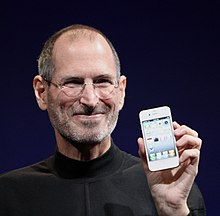Steve Jobs
Jobs was born in San Francisco, California, to parents who put him up for adoption at birth. He was raised in the San Francisco Bay Area during the 1960s.[3] He attended Reed College in 1972 before dropping out,[4] and traveled through India in 1974 seeking enlightenment and studying Zen Buddhism.[5] His declassified FBI report states that he used marijuana and LSD while he was in college,[6] and he once told a reporter that taking LSD was "one of the two or three most important things" that he did in his life.[7]
Jobs and Wozniak co-founded Apple in 1976 to sell Wozniak's Apple I personal computer. The duo gained fame and wealth a year later for the Apple II, one of the first highly successful mass-produced personal computers. Jobs saw the commercial potential of the Xerox Alto in 1979, which was mouse-driven and had a graphical user interface (GUI). This led to development of the unsuccessful Apple Lisa in 1983, followed by the breakthrough Macintosh in 1984, the first mass-produced computer with a GUI. The Macintosh introduced the desktop publishing industry in 1985 with the addition of the Apple LaserWriter, the first laser printer to feature vector graphics. Jobs was forced out of Apple in 1985 after a long power struggle.[8]:310
Jobs took a few of Apple's members with him to found NeXT, a computer platform development company that specialized in computers for higher-education and business markets. In addition, he helped to develop the visual effects industry when he funded the computer graphics division of George Lucas's Lucasfilm in 1986.[9] The new company was Pixar, which produced Toy Story, the first fully computer-animated film.
Apple merged with NeXT in 1997, and Jobs became CEO of his former company within a few months. He revived Apple, which had been at the verge of bankruptcy. He worked closely with designer Jonathan Ive to develop a line of products that had larger cultural ramifications, beginning in 1997 with the "Think different" advertising campaign and leading to the iMac, iTunes, iTunes Store, Apple Store, iPod, iPhone, App Store, and the iPad. In 2001, the original Mac OS was replaced with a completely new Mac OS X, based on NeXT's NeXTSTEP platform, giving the OS a modern Unix-based foundation for the first time.

Hello,
Not indicating that the content you post including translations, spun, or re-written articles are not your original work could be seen as plagiarism.
These are some tips on how to share content and add value:
Repeated plagiarized posts are considered spam. Spam is discouraged by the community, and may result in action from the cheetah bot.
If you are actually the original author, please do reply to let us know!
More Info: Abuse Guide - 2017.
If you reply to this comment directly, we may not notice your response.
It is recommended to contact us in our Discord Channel, instead.
Thank you.
Hi! I am a robot. I just upvoted you! I found similar content that readers might be interested in:
https://www.facebook.com/efetechnology